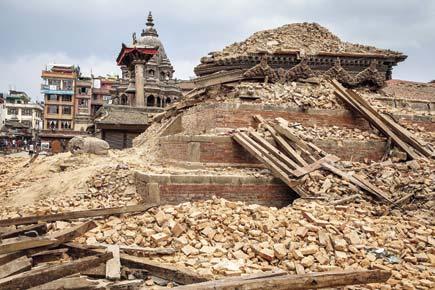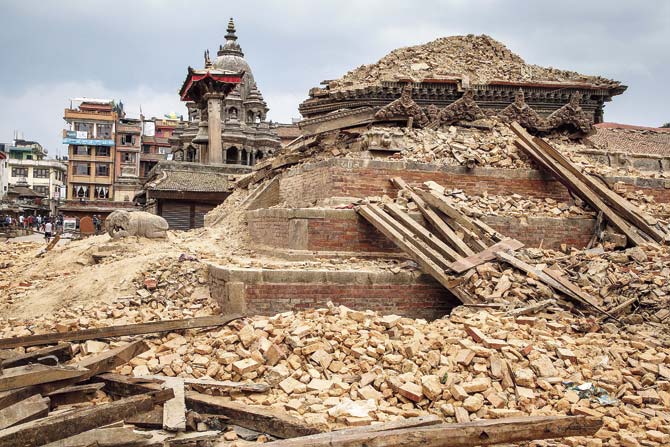Amidst all the pain, devastation, destruction and death wrought by Saturday’s earthquake in Nepal is the miserable understanding that the death toll will be high and the poorest will suffer the most

 Amidst all the pain, devastation, destruction and death wrought by Saturday’s earthquake in Nepal is the miserable understanding that the death toll will be high and the poorest will suffer the most. Listening to earthquake-affected people talk on television, the underlying heart-breaking story is familiar to anyone in the subcontinent: a lack of disaster management and preparedness.
Amidst all the pain, devastation, destruction and death wrought by Saturday’s earthquake in Nepal is the miserable understanding that the death toll will be high and the poorest will suffer the most. Listening to earthquake-affected people talk on television, the underlying heart-breaking story is familiar to anyone in the subcontinent: a lack of disaster management and preparedness.
ADVERTISEMENT
For years, we have heard all those cliches about human life being cheap in India and about how our philosophical or fatalistic attitude to life makes us more prone to accept death.

Kathmandu’s Durbar Square is a massive historical loss. But what about all those other buildings which should have been built according to more stringent norms in an earthquake-prone area? Pic/Getty Images
The same applies more or less to our neighbours. International aid will pour in, the better off will send money just a click away on the Internet but the essential organisation to prevent human misery at the next catastrophe will remain slipshod. Because we will forget, until the next one comes along.
The UN’s aid and related wings, the International Red Cross, Doctors Without Borders and others like them for all that NGOs are made into bogeys for political gain will do their best to provide material assistance. As we have seen in Nepal, the Indian armed forces are exemplary in its efforts and abilities. Across India as well, it is they who top at search-and-rescue. But we have been unable to set up a civilian force that can match or complement them.
Mumbai knows all too miserably how it works. Almost none of the promises made after the worst-ever floods of 2005 or the 2008 terror attacks have been fulfilled. Everything just fell to the twin terrors of red tape and official apathy, and there was no political will to go beyond it. Boats were bought but diesel was not sanctioned, is the story that emphasises our situation.
Some chaos is understandable when a calamity of this magnitude strikes. But if you have a proper disaster management plan in place, then you can regroup and work out search, rescue and rehabilitation modalities. India, in that sense, has no business to continue to behave like a third-world nation. We surely have the capabilities to be better. The question is, why don’t we seem to want to?
Then there’s the big fat elephant in the room: shoddy or complete lack of construction and restoration standards. Loss of life often comes from some combination of all this. Kathmandu’s Durbar Square is a massive historical loss. But what about all those other buildings which should have been built according to more stringent norms in an earthquake-prone area? All the shortcuts that we take as citizens because we think it will never happen to us. Sometimes collective bravado can lead to massive suffering.
Buildings that are constructed on lake or river beds, buildings which are legalised after the fact because it is easier to pay a fine later than follow a law first these are the giants which have to be vanquished. Imagine what would happen, for instance, to all these huge tall towers of glass coming up all over India’s seismic zones because of a current fad? The image is too terrifying to consider.
Parts of Gujarat went through massive retro-fitting after the catastrophic earthquake of 2001. Yet, even then, some damage could’ve been contained if building standards had been adhered to. But looking at the unbridled galloping construction all over India right now and the easy way in which money changes hands at all levels when it comes to construction, development, and real estate, you would be extremely naïve if you imagined that everything was above board. And even worse, that you are safe.
Without being a scare-monger, how seriously do we have to take a wake-up call? It is one thing to be an optimist and have a positive attitude to life. And it is another thing to behave like so many of India’s two-wheeler drivers, who firmly believe that helmets are for other people.
They’re not, you know. The answer, perhaps, is not in fearing death, but in taking it more seriously.
Ranjona Banerji is a senior journalist. You can follow her on Twitter @ranjona
 Subscribe today by clicking the link and stay updated with the latest news!" Click here!
Subscribe today by clicking the link and stay updated with the latest news!" Click here!






